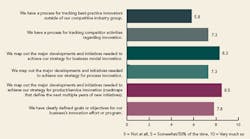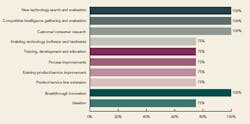What Drives the Most Innovative Companies?
Innovation challenges organizations of all types and sizes across all industries. As part of its consortium research study, APQC analyzed how companies are innovating in the following areas:
- Products/services;
- Core processes and operations;
- Business model development, including business relationships such as joint ventures and partnerships with suppliers, customers or competitors;
- Innovation enablers, or the culture, tools and structures that create an environment where innovation thrives.
In its 2006 study, Innovation: Putting Ideas into Action, APQC found Bausch & Lomb, IBM, Kennametal Inc., Mayo Clinic, Procter & Gamble and The Clorox Company to be leaders in innovation. Even though they operate in very different industries, these companies articulate and commit to an innovation strategy. They balance their innovation portfolios, and they extend innovation beyond their own boundaries. In this article, we distill lessons from last years survey that can be applied to pharmaceutical manufacturing, and invite companies to take part in our 2007 survey (see Collect Your Own Measures at No Cost, below), results of which will be interpreted in Pharmaceutical Manufacturing and on our Web site later this year.
Strategy and Commitment
For innovation to be a long-term strategy, it must be linked with the organizations overall strategy, and visible commitments of money and resources must be made. Leaders in innovation provide financial resources and clear goals and objectives. At these organizations, innovation is clearly stated as a corporate value.
Even if they may not have a discrete budget for it, the best innovators provide adequate funding for innovation. On average, best-practice organizations allocate more resources than others, averaging 7.7 out of 10 for increasing the resources available for innovation, compared to 6.5 for other respondents. Leaders have clearly defined goals, and map the development of their innovation strategies to a greater extent than do the other organizations participating in the research. Figure 1 (below) illustrates the strategic approaches taken by the leading organizations.
In order to keep innovations aligned with overall business strategy, it is essential to determine the strategic fit. Key questions are:
- Is this truly the right market?
- What will it take to succeed?
- How can we advance in that market?
- Can we succeed?
Bausch & Lomb has created development committees in its major business categories to define product-specific innovation strategies. Each development committee is responsible for evaluating business opportunities, approving business cases and evaluating benefits. Development committees then convert business strategy to product strategy and product strategy to project strategy. These committees also are responsible for funding and resource allocation in support of innovation.
IBM believes that the mastery of innovation is vital to an organizations long-term well-being; therefore, the company focuses on innovation across three interconnected dimensions: product/offerings, process and business model innovation. IBM provides resources and funding for all three kinds of innovation. IBMs innovation framework includes:
- New ways to reach out and meet the needs of customers through products and services, markets, audiences, channels and paths to delivery.
- Business/enterprise models, including enterprise realignment, strategic redefinition and industry ecosystem and networks.
- Operations, driven by the need to change outcomes significantly or the need to support new products, services, markets and channels. It takes into account differentiated processes, partners and teams.
- Sustaining enablers that create an environment where innovation thrives. These include idea generation, creating a climate for creativity, organizational structure and incubation, technologies and tools, and collaboration.
Balanced Portfolio
Successful innovators must also excel at two fundamentally different types of innovation; one type bolsters its position in a core business, while the other creates new businesses. However, the tools, metrics, processes and interactions with management can be very different for the two activities.
Innovation can be incremental or radical, but companies should also consider the impact of their innovation: will it sustain an established improvement path or disrupt it?
Figure 2 (below) shows how innovation leaders spend on innovation. Interestingly enough, all of the most innovative organizations invest in breakthrough innovations, while only 38% of the others do. Leaders and laggards were also divided on their policies regarding expenditures for new technology research and evaluation, competitive intelligence and customer research.
The best-practice organizations studied have all developed a method for deciding where to invest their innovation resources. One approach to classifying innovations uses three categories: sustaining, breakout and disruptive. Sustaining innovation involves both incremental improvements and evolutionary changes to maintain a brand and keep it healthy. Breakout innovation can be seen as a step function change leading to higher growth rates and premium prices that foster growth in a category. Disruptive innovation, in many cases, involves creating totally new categories with new benefits and the highest growth rates.
Another approach to innovation classification recognizes the need to categorize innovations based on their market impact. For one of the bestpractice organizations, game-changing does not always mean radically new products or services. A game-changing innovation could be making an old product with new or different materials. The breakthrough would be developing new materials for use in the product, which allows the organization to rapidly proliferate the use of those new materials, particularly in new markets.
One organization has developed a project prioritization model in which the prioritization decisions correspond to the return the company anticipates in each area. The smallest return (e.g., introducing a similar new product after a competitor has introduced a new product) has not historically been the most successful, as these opportunities are typically not sustainable and are more focused on share defense. The company instead strategically focuses its energy on larger projects to grow products and categories and, in some instances, to create new categories of products.
To ensure balance in their innovation portfolios, some organizations are establishing a centralized group that focuses more on long-term innovation, while the operating units continue to have a shorter-term focus. This central group also often looks at new technologies and new or tangential markets that are adjacent to existing technologies and markets.
A third approach to classifying innovations, which is used by IBM, begins with examining opportunities based on time required and level of uncertainty and dividing them into three horizons. Horizon 1 is considered the core business, where the goal is to extend, defend and increase productivity and profit contribution. Most of the management structures and typical measurements of the company are focused on this horizon. Measures typically used in this horizon include profit, cost, return on invested capital, and productivity or efficiency.
Horizon 2 includes growth business. The focus here is to scale proven business models, increase market share and grow the opportunity. Measures that are more appropriate at this stage include market share gains, high revenue growth, new customer acquisitions and profit.
Horizon 3 is where emerging business opportunities are located. The goal of this area, which has the highest level of uncertainty, is to test business models, prove viability, capabilities and value while seeding growth opportunities.
Given the longer time range for innovations in Horizon 3, some measures that may help include project-based milestones, in-market pilots and creating the business design.
External Focus
A strong external focus allows innovative organizations to look beyond themselves for solutions, opportunities and insights that become part of their strategic innovation portfolio. The following list of external groups is in order of degree of integration into the innovation process, with the highest degree of integration listed first:
- Strategic partners (8.3 on a 10-point scale)
- Customers
- Suppliers
- Universities
- Consultants
- Research organizations
- Advertising agencies (3.0 on a 10-point scale)
Leaders in innovation search for ideas from external sources more than others, averaging 6 out of 10 versus 4.8 out of 10 for the others.
For example, P&G is looking to external partnerships with competitors, small businesses or individuals, to supply the company with more than half of its new technologies and products. Rather than building up its own infrastructure, P&G seeks external partners who have already made that investment in equipment, processes and tools. This allows P&G to leverage its infostructure instead of adding costly infrastructure. These partnerships have produced successes with new products.
As a part of P&Gs paradigm shift to being more externally focused, its R&D people are asked to consider the following sources prior to beginning an innovation project:
- Does this already exist inside P&G, maybe in another business unit?
- Have you looked to see whether the companys suppliers already have it?
- Does it exist somewhere else in the world?
Only after rigorous research has found that the answer to all three questions is no can the idea be explored.
IBM has created an innovation ecosystem with external organizations to help foster the environment for collaborative innovation. Members of its innovation ecosystem include:
- keystone clients;
- government agencies (national, state and local);
- universities and academia;
- venture capitalists;
- IT analysts;
- financial analysts;
- standards bodies;
- former IBM employees;
- business partners;
- independent software vendors;
- non-governmental organizations.
About the Author
Marisa Brown is the manager of APQCs Collaborative Learning Group. Since she joined the Center in January 1996, Brown has been integrally involved with the all aspects of multi-client benchmarking studies. She has managed some of APQCs largest consortium benchmarking studies in education and learning, marketing, and new product development.
Reference
1. Cooper, R.G., Edgett, S. J., and Kleinschmidt, E.J. Portfolio ManagementFundamental to New Product Success. Working Paper No. 12. Product Development Institute, 2001.
Collect Your Own Measures at No CostPharmaceutical Manufacturing magazine, APQC and IBM offer a unique benchmarking opportunity to compare your organization against top performers by participating in the Open Standards Benchmarking Collaborative (OSBC) research program at no cost. By participating in this innovation research project, you will gain insight across multiple dimensions of innovation. You will receive a complimentary benchmarking report that will include an overview of the practices and processes that top organizations have in place to achieve peak performance. Visit www.apqc.org/pharma-inn to learn how your organizations focus on innovation compares in terms of capabilities, costs, productivity, efficiency and cycle times. |


